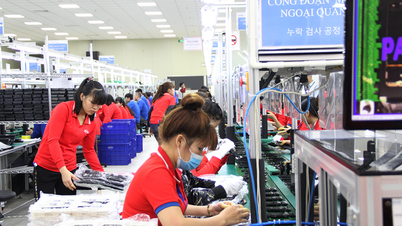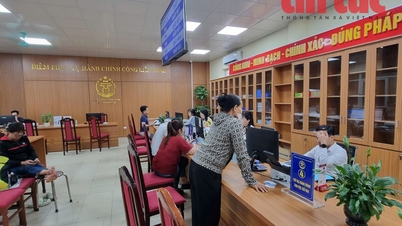Three scenarios for the 20% target by 2025
At the forum "Establishing a new growth model for Vietnam in the 2026-2030 period, with a vision to 2030" on July 15 in Hanoi, Professor, Dr. Tran Tho Dat - Chairman of the Council of the National Economics University, made in-depth analysis of the current situation and proposed scenarios for the upcoming journey.
The digital economy is identified as one of the important growth drivers, helping Vietnam establish a new growth method, especially in the context of green growth. Vietnam's digital economy is currently assessed to have a fairly high growth rate in the region.
However, a major problem that exists is the lack of consistency in statistics. This makes it difficult to make policies and evaluate effectiveness.
"The General Statistics Office (now the General Statistics Office) announced that the proportion of Vietnam's digital economy in 2024 will only reach 13.17%. With this figure, to reach the target of 20% by 2025, the digital economy will need a growth rate "like Thanh Giong".

Meanwhile, the National Committee on Digital Transformation estimates that this figure has now reached about 18%. Based on this figure, the 20% target is completely feasible," the expert said.
In addition to the data discrepancy, the Chairman of the National Economics University Council also pointed out a "Solow paradox" that exists in Vietnam. That is, investment in information technology has increased sharply but productivity growth is not commensurate. This shows that the effectiveness of investment and digital transformation still has many problems.
From the above situation, Professor, Dr. Tran Tho Dat has proposed three scenarios to assess the possibility of achieving the target of 20% GDP from the digital economy by 2025.
Scenario 1: Breakthrough growth: Based on the 13.17% figure of the General Statistics Office, Vietnam will need a breakthrough growth, many times higher than the previous period. This is a huge challenge, almost impossible without breakthroughs.
Scenario 2: Comprehensive recalculation. It is necessary to recalculate the value of the digital economy in a more complete and comprehensive way. If the National Committee's estimate of 18% is followed, the possibility of reaching 20% by 2025 is completely feasible. The key is to gather all the elements that make up the digital economy.
Scenario 3: Strategic investment. This is a long-term scenario, requiring strong investment in information technology infrastructure, both hardware and software. According to Professor Dat, only when the "core digital economy" develops firmly, can the "spreading digital economy" develop and contribute positively to overall growth.
Compared with countries like India, China, Indonesia, Malaysia, Thailand, according to experts, Vietnam has its own advantages and limitations.
In terms of institutions, Vietnam is one of the leading countries in having laws on digital technology industry and personal data protection. Meanwhile, in terms of infrastructure and human resources, these are major bottlenecks. Despite wide Internet coverage, 5G subscription rates are still low and there is a large gap in accessibility between urban and rural areas. Although the digital human resources are large in quantity, the quality is considered lower than the ASEAN average.
Core solutions
For the digital economy to truly become a growth driver, Professor, Dr. Tran Tho Dat believes that the core solution lies in investing in infrastructure.
"In recent times, we have paid great attention to large projects on transport infrastructure. However, if we consider the digital economy as a strong growth driver, we must invest heavily in it. I really hope that the Government will have large investment projects on information technology infrastructure, both hardware and software," Professor Tran Tho Dat proposed.
According to the explanation of the Chairman of the Council of the National Economics University, if we only focus on transport infrastructure and "forget" digital infrastructure, it will be very difficult for the digital economy to fully exploit its potential. Therefore, the key solutions in the coming time must be: perfecting institutions, developing synchronous digital infrastructure, improving the quality of human resources and promoting innovation in a substantial way. Only then can the goal of the digital economy accounting for 20% of GDP become a reality.
Source: https://doanhnghiepvn.vn/cong-nghe/kinh-te-so-viet-nam-va-thach-thuc-tang-truong-nhu-thanh-giong/20250716093403517




![[Photo] Prime Minister Pham Minh Chinh meets with South African President Matamela Cyril Ramaphosa](https://vphoto.vietnam.vn/thumb/1200x675/vietnam/resource/IMAGE/2025/10/23/1761226081024_dsc-9845-jpg.webp)
![[Photo] President Luong Cuong holds talks with South African President Matamela Cyril Ramaphosa](https://vphoto.vietnam.vn/thumb/1200x675/vietnam/resource/IMAGE/2025/10/23/1761221878741_ndo_br_1-8416-jpg.webp)

![[Photo] Prime Minister Pham Minh Chinh chairs meeting on railway projects](https://vphoto.vietnam.vn/thumb/1200x675/vietnam/resource/IMAGE/2025/10/23/1761206277171_dsc-9703-jpg.webp)








































































































Comment (0)